BIM's Impact on Stakeholder Collaboration in Construction Projects
VerifiedAdded on 2023/06/07
|14
|4332
|112
Essay
AI Summary
This essay examines the role of Building Information Modelling (BIM) in enhancing project collaboration among stakeholders in the construction industry. It highlights how BIM facilitates data management, communication, and efficiency throughout the building lifecycle, from design and planning to construction and deconstruction. The essay also discusses the evolving roles and responsibilities of BIM managers in ensuring successful BIM implementation, including strategic planning, workflow supervision, and stakeholder collaboration. Challenges such as resistance to change, data security, and interoperability are addressed, emphasizing the need for comprehensive training and personalized collaboration systems. The importance of stakeholder engagement, cost-effectiveness, and the integration of BIM into traditional building renovation and deconstruction processes are also explored, underscoring BIM's potential to revolutionize construction project delivery.
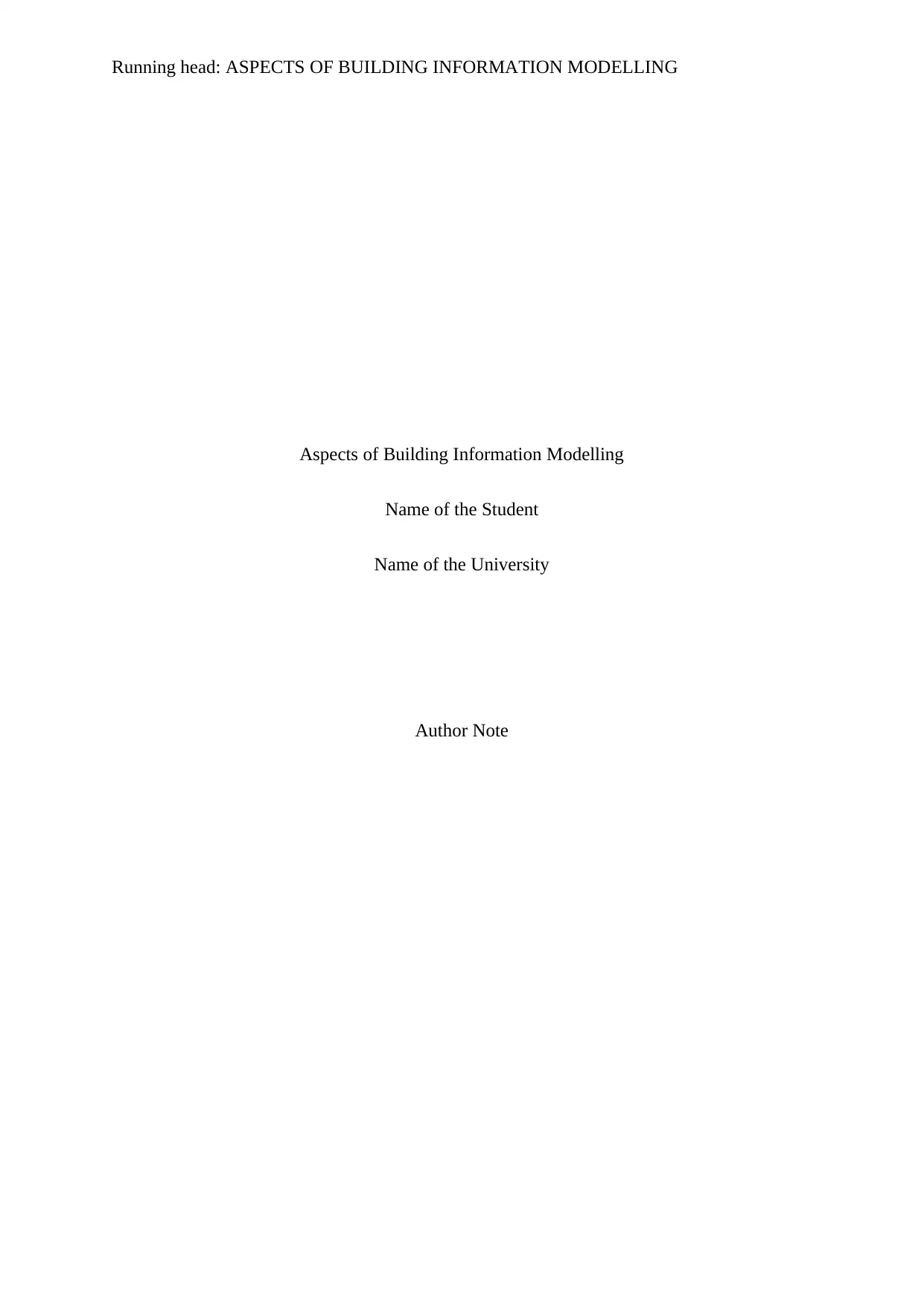
Running head: ASPECTS OF BUILDING INFORMATION MODELLING
Aspects of Building Information Modelling
Name of the Student
Name of the University
Author Note
Aspects of Building Information Modelling
Name of the Student
Name of the University
Author Note
Paraphrase This Document
Need a fresh take? Get an instant paraphrase of this document with our AI Paraphraser
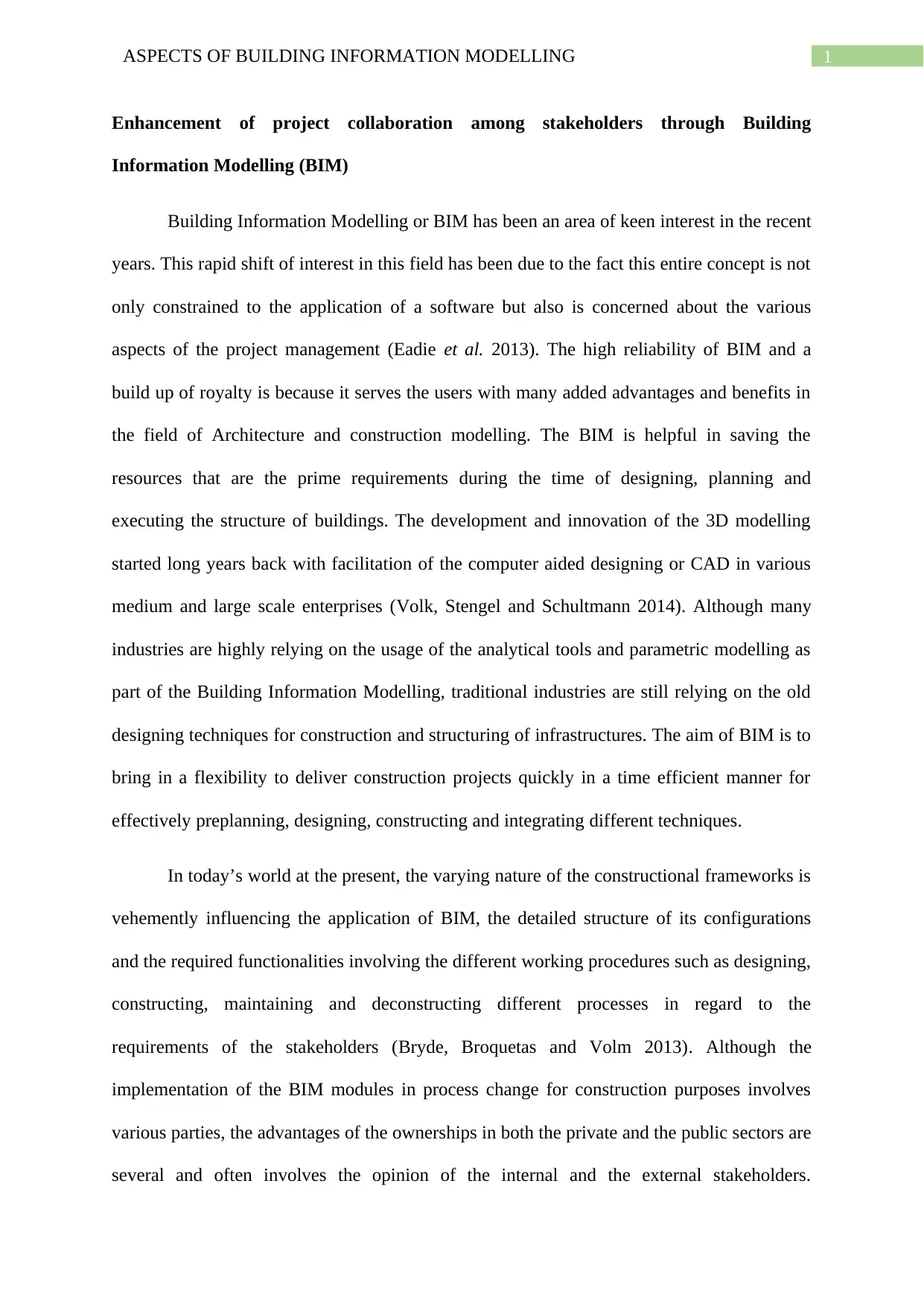
1ASPECTS OF BUILDING INFORMATION MODELLING
Enhancement of project collaboration among stakeholders through Building
Information Modelling (BIM)
Building Information Modelling or BIM has been an area of keen interest in the recent
years. This rapid shift of interest in this field has been due to the fact this entire concept is not
only constrained to the application of a software but also is concerned about the various
aspects of the project management (Eadie et al. 2013). The high reliability of BIM and a
build up of royalty is because it serves the users with many added advantages and benefits in
the field of Architecture and construction modelling. The BIM is helpful in saving the
resources that are the prime requirements during the time of designing, planning and
executing the structure of buildings. The development and innovation of the 3D modelling
started long years back with facilitation of the computer aided designing or CAD in various
medium and large scale enterprises (Volk, Stengel and Schultmann 2014). Although many
industries are highly relying on the usage of the analytical tools and parametric modelling as
part of the Building Information Modelling, traditional industries are still relying on the old
designing techniques for construction and structuring of infrastructures. The aim of BIM is to
bring in a flexibility to deliver construction projects quickly in a time efficient manner for
effectively preplanning, designing, constructing and integrating different techniques.
In today’s world at the present, the varying nature of the constructional frameworks is
vehemently influencing the application of BIM, the detailed structure of its configurations
and the required functionalities involving the different working procedures such as designing,
constructing, maintaining and deconstructing different processes in regard to the
requirements of the stakeholders (Bryde, Broquetas and Volm 2013). Although the
implementation of the BIM modules in process change for construction purposes involves
various parties, the advantages of the ownerships in both the private and the public sectors are
several and often involves the opinion of the internal and the external stakeholders.
Enhancement of project collaboration among stakeholders through Building
Information Modelling (BIM)
Building Information Modelling or BIM has been an area of keen interest in the recent
years. This rapid shift of interest in this field has been due to the fact this entire concept is not
only constrained to the application of a software but also is concerned about the various
aspects of the project management (Eadie et al. 2013). The high reliability of BIM and a
build up of royalty is because it serves the users with many added advantages and benefits in
the field of Architecture and construction modelling. The BIM is helpful in saving the
resources that are the prime requirements during the time of designing, planning and
executing the structure of buildings. The development and innovation of the 3D modelling
started long years back with facilitation of the computer aided designing or CAD in various
medium and large scale enterprises (Volk, Stengel and Schultmann 2014). Although many
industries are highly relying on the usage of the analytical tools and parametric modelling as
part of the Building Information Modelling, traditional industries are still relying on the old
designing techniques for construction and structuring of infrastructures. The aim of BIM is to
bring in a flexibility to deliver construction projects quickly in a time efficient manner for
effectively preplanning, designing, constructing and integrating different techniques.
In today’s world at the present, the varying nature of the constructional frameworks is
vehemently influencing the application of BIM, the detailed structure of its configurations
and the required functionalities involving the different working procedures such as designing,
constructing, maintaining and deconstructing different processes in regard to the
requirements of the stakeholders (Bryde, Broquetas and Volm 2013). Although the
implementation of the BIM modules in process change for construction purposes involves
various parties, the advantages of the ownerships in both the private and the public sectors are
several and often involves the opinion of the internal and the external stakeholders.
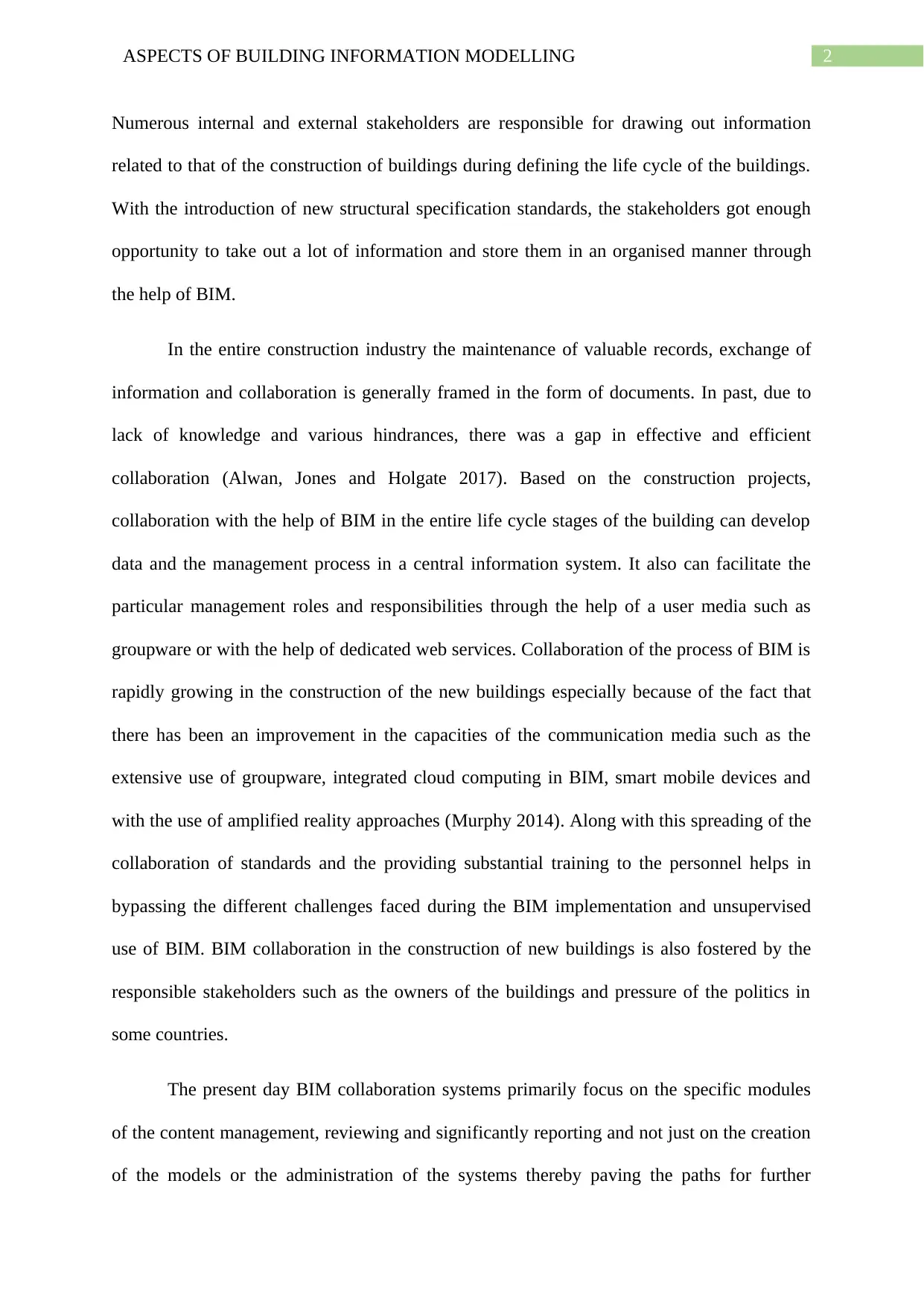
2ASPECTS OF BUILDING INFORMATION MODELLING
Numerous internal and external stakeholders are responsible for drawing out information
related to that of the construction of buildings during defining the life cycle of the buildings.
With the introduction of new structural specification standards, the stakeholders got enough
opportunity to take out a lot of information and store them in an organised manner through
the help of BIM.
In the entire construction industry the maintenance of valuable records, exchange of
information and collaboration is generally framed in the form of documents. In past, due to
lack of knowledge and various hindrances, there was a gap in effective and efficient
collaboration (Alwan, Jones and Holgate 2017). Based on the construction projects,
collaboration with the help of BIM in the entire life cycle stages of the building can develop
data and the management process in a central information system. It also can facilitate the
particular management roles and responsibilities through the help of a user media such as
groupware or with the help of dedicated web services. Collaboration of the process of BIM is
rapidly growing in the construction of the new buildings especially because of the fact that
there has been an improvement in the capacities of the communication media such as the
extensive use of groupware, integrated cloud computing in BIM, smart mobile devices and
with the use of amplified reality approaches (Murphy 2014). Along with this spreading of the
collaboration of standards and the providing substantial training to the personnel helps in
bypassing the different challenges faced during the BIM implementation and unsupervised
use of BIM. BIM collaboration in the construction of new buildings is also fostered by the
responsible stakeholders such as the owners of the buildings and pressure of the politics in
some countries.
The present day BIM collaboration systems primarily focus on the specific modules
of the content management, reviewing and significantly reporting and not just on the creation
of the models or the administration of the systems thereby paving the paths for further
Numerous internal and external stakeholders are responsible for drawing out information
related to that of the construction of buildings during defining the life cycle of the buildings.
With the introduction of new structural specification standards, the stakeholders got enough
opportunity to take out a lot of information and store them in an organised manner through
the help of BIM.
In the entire construction industry the maintenance of valuable records, exchange of
information and collaboration is generally framed in the form of documents. In past, due to
lack of knowledge and various hindrances, there was a gap in effective and efficient
collaboration (Alwan, Jones and Holgate 2017). Based on the construction projects,
collaboration with the help of BIM in the entire life cycle stages of the building can develop
data and the management process in a central information system. It also can facilitate the
particular management roles and responsibilities through the help of a user media such as
groupware or with the help of dedicated web services. Collaboration of the process of BIM is
rapidly growing in the construction of the new buildings especially because of the fact that
there has been an improvement in the capacities of the communication media such as the
extensive use of groupware, integrated cloud computing in BIM, smart mobile devices and
with the use of amplified reality approaches (Murphy 2014). Along with this spreading of the
collaboration of standards and the providing substantial training to the personnel helps in
bypassing the different challenges faced during the BIM implementation and unsupervised
use of BIM. BIM collaboration in the construction of new buildings is also fostered by the
responsible stakeholders such as the owners of the buildings and pressure of the politics in
some countries.
The present day BIM collaboration systems primarily focus on the specific modules
of the content management, reviewing and significantly reporting and not just on the creation
of the models or the administration of the systems thereby paving the paths for further
⊘ This is a preview!⊘
Do you want full access?
Subscribe today to unlock all pages.

Trusted by 1+ million students worldwide
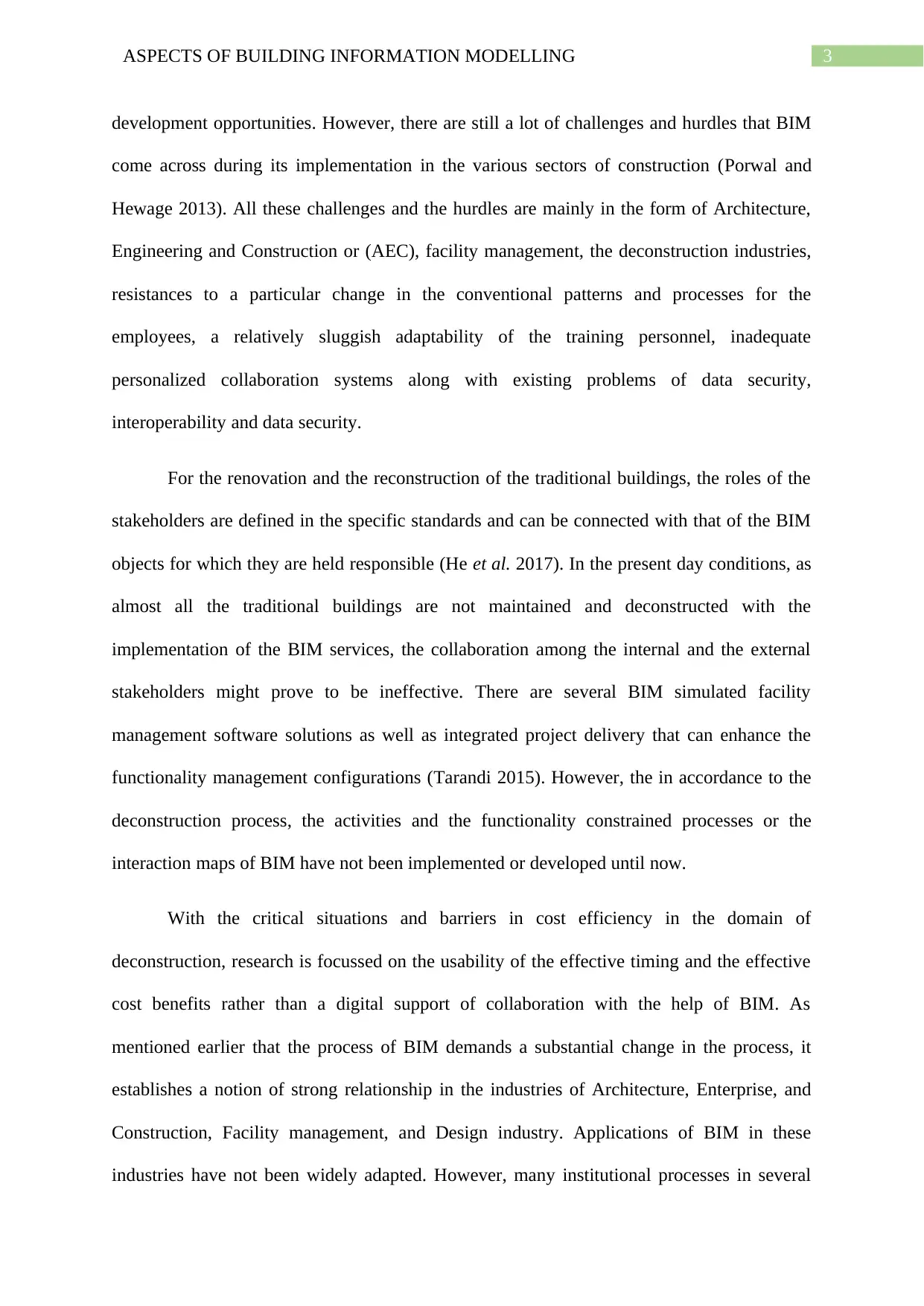
3ASPECTS OF BUILDING INFORMATION MODELLING
development opportunities. However, there are still a lot of challenges and hurdles that BIM
come across during its implementation in the various sectors of construction (Porwal and
Hewage 2013). All these challenges and the hurdles are mainly in the form of Architecture,
Engineering and Construction or (AEC), facility management, the deconstruction industries,
resistances to a particular change in the conventional patterns and processes for the
employees, a relatively sluggish adaptability of the training personnel, inadequate
personalized collaboration systems along with existing problems of data security,
interoperability and data security.
For the renovation and the reconstruction of the traditional buildings, the roles of the
stakeholders are defined in the specific standards and can be connected with that of the BIM
objects for which they are held responsible (He et al. 2017). In the present day conditions, as
almost all the traditional buildings are not maintained and deconstructed with the
implementation of the BIM services, the collaboration among the internal and the external
stakeholders might prove to be ineffective. There are several BIM simulated facility
management software solutions as well as integrated project delivery that can enhance the
functionality management configurations (Tarandi 2015). However, the in accordance to the
deconstruction process, the activities and the functionality constrained processes or the
interaction maps of BIM have not been implemented or developed until now.
With the critical situations and barriers in cost efficiency in the domain of
deconstruction, research is focussed on the usability of the effective timing and the effective
cost benefits rather than a digital support of collaboration with the help of BIM. As
mentioned earlier that the process of BIM demands a substantial change in the process, it
establishes a notion of strong relationship in the industries of Architecture, Enterprise, and
Construction, Facility management, and Design industry. Applications of BIM in these
industries have not been widely adapted. However, many institutional processes in several
development opportunities. However, there are still a lot of challenges and hurdles that BIM
come across during its implementation in the various sectors of construction (Porwal and
Hewage 2013). All these challenges and the hurdles are mainly in the form of Architecture,
Engineering and Construction or (AEC), facility management, the deconstruction industries,
resistances to a particular change in the conventional patterns and processes for the
employees, a relatively sluggish adaptability of the training personnel, inadequate
personalized collaboration systems along with existing problems of data security,
interoperability and data security.
For the renovation and the reconstruction of the traditional buildings, the roles of the
stakeholders are defined in the specific standards and can be connected with that of the BIM
objects for which they are held responsible (He et al. 2017). In the present day conditions, as
almost all the traditional buildings are not maintained and deconstructed with the
implementation of the BIM services, the collaboration among the internal and the external
stakeholders might prove to be ineffective. There are several BIM simulated facility
management software solutions as well as integrated project delivery that can enhance the
functionality management configurations (Tarandi 2015). However, the in accordance to the
deconstruction process, the activities and the functionality constrained processes or the
interaction maps of BIM have not been implemented or developed until now.
With the critical situations and barriers in cost efficiency in the domain of
deconstruction, research is focussed on the usability of the effective timing and the effective
cost benefits rather than a digital support of collaboration with the help of BIM. As
mentioned earlier that the process of BIM demands a substantial change in the process, it
establishes a notion of strong relationship in the industries of Architecture, Enterprise, and
Construction, Facility management, and Design industry. Applications of BIM in these
industries have not been widely adapted. However, many institutional processes in several
Paraphrase This Document
Need a fresh take? Get an instant paraphrase of this document with our AI Paraphraser
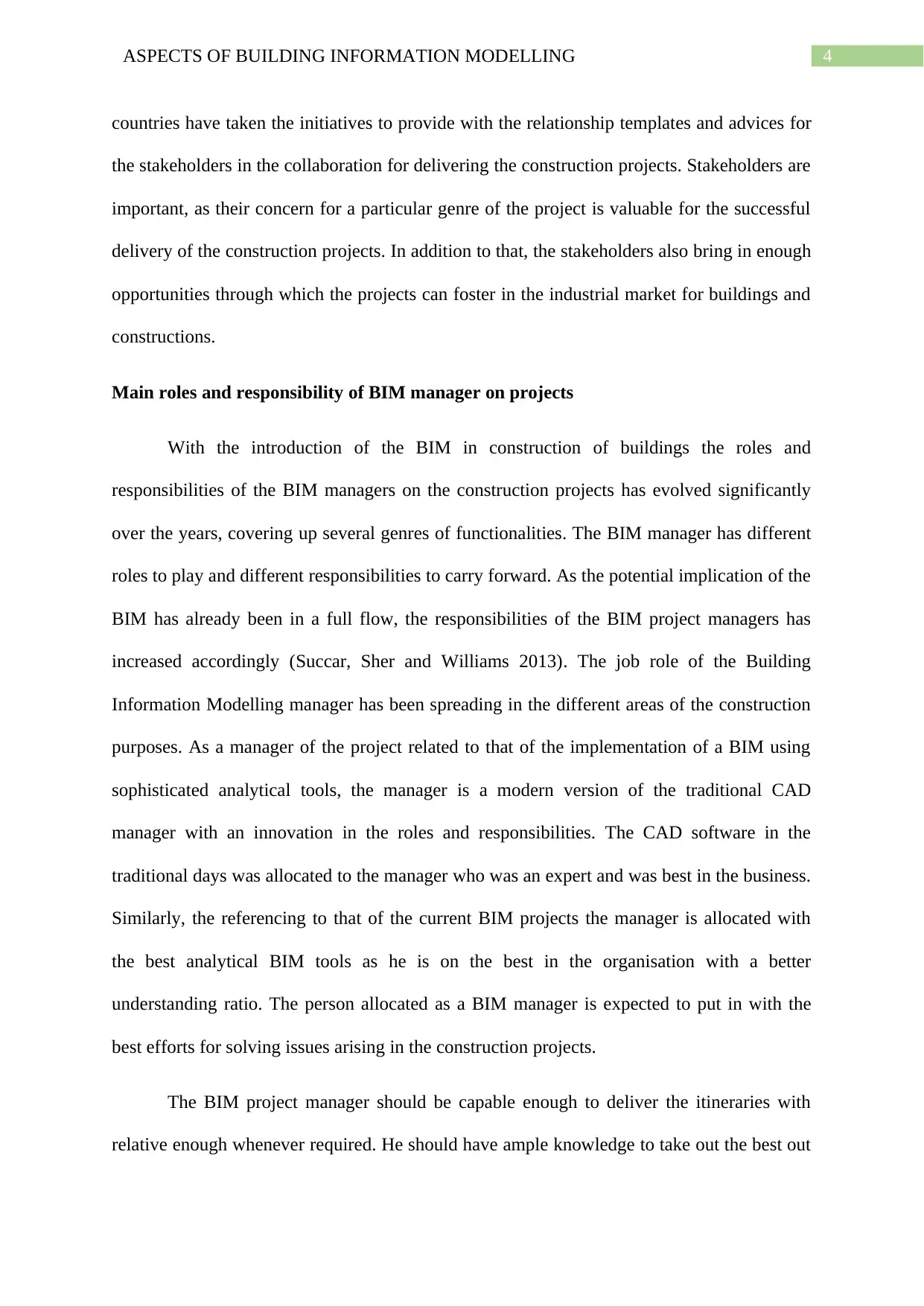
4ASPECTS OF BUILDING INFORMATION MODELLING
countries have taken the initiatives to provide with the relationship templates and advices for
the stakeholders in the collaboration for delivering the construction projects. Stakeholders are
important, as their concern for a particular genre of the project is valuable for the successful
delivery of the construction projects. In addition to that, the stakeholders also bring in enough
opportunities through which the projects can foster in the industrial market for buildings and
constructions.
Main roles and responsibility of BIM manager on projects
With the introduction of the BIM in construction of buildings the roles and
responsibilities of the BIM managers on the construction projects has evolved significantly
over the years, covering up several genres of functionalities. The BIM manager has different
roles to play and different responsibilities to carry forward. As the potential implication of the
BIM has already been in a full flow, the responsibilities of the BIM project managers has
increased accordingly (Succar, Sher and Williams 2013). The job role of the Building
Information Modelling manager has been spreading in the different areas of the construction
purposes. As a manager of the project related to that of the implementation of a BIM using
sophisticated analytical tools, the manager is a modern version of the traditional CAD
manager with an innovation in the roles and responsibilities. The CAD software in the
traditional days was allocated to the manager who was an expert and was best in the business.
Similarly, the referencing to that of the current BIM projects the manager is allocated with
the best analytical BIM tools as he is on the best in the organisation with a better
understanding ratio. The person allocated as a BIM manager is expected to put in with the
best efforts for solving issues arising in the construction projects.
The BIM project manager should be capable enough to deliver the itineraries with
relative enough whenever required. He should have ample knowledge to take out the best out
countries have taken the initiatives to provide with the relationship templates and advices for
the stakeholders in the collaboration for delivering the construction projects. Stakeholders are
important, as their concern for a particular genre of the project is valuable for the successful
delivery of the construction projects. In addition to that, the stakeholders also bring in enough
opportunities through which the projects can foster in the industrial market for buildings and
constructions.
Main roles and responsibility of BIM manager on projects
With the introduction of the BIM in construction of buildings the roles and
responsibilities of the BIM managers on the construction projects has evolved significantly
over the years, covering up several genres of functionalities. The BIM manager has different
roles to play and different responsibilities to carry forward. As the potential implication of the
BIM has already been in a full flow, the responsibilities of the BIM project managers has
increased accordingly (Succar, Sher and Williams 2013). The job role of the Building
Information Modelling manager has been spreading in the different areas of the construction
purposes. As a manager of the project related to that of the implementation of a BIM using
sophisticated analytical tools, the manager is a modern version of the traditional CAD
manager with an innovation in the roles and responsibilities. The CAD software in the
traditional days was allocated to the manager who was an expert and was best in the business.
Similarly, the referencing to that of the current BIM projects the manager is allocated with
the best analytical BIM tools as he is on the best in the organisation with a better
understanding ratio. The person allocated as a BIM manager is expected to put in with the
best efforts for solving issues arising in the construction projects.
The BIM project manager should be capable enough to deliver the itineraries with
relative enough whenever required. He should have ample knowledge to take out the best out
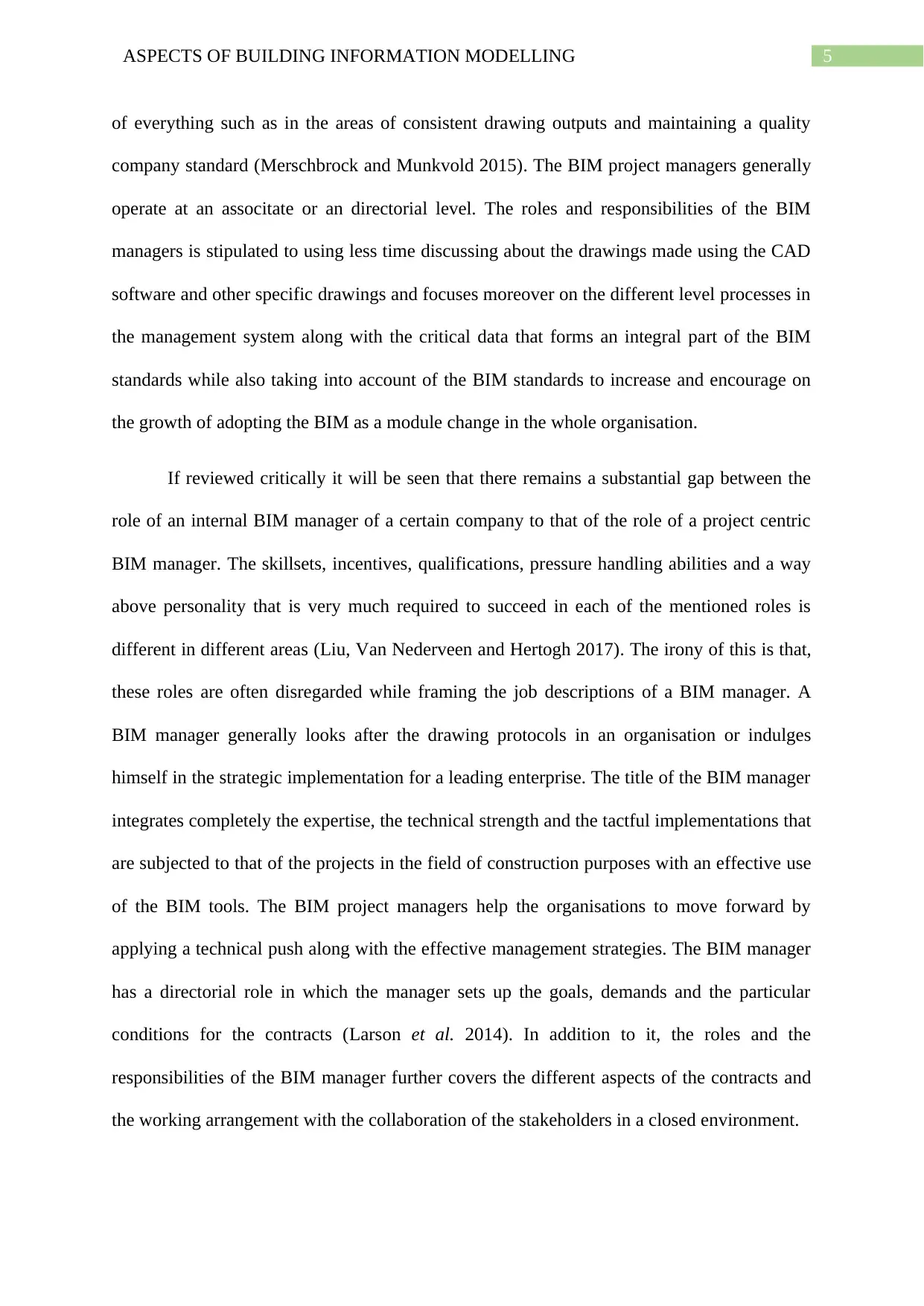
5ASPECTS OF BUILDING INFORMATION MODELLING
of everything such as in the areas of consistent drawing outputs and maintaining a quality
company standard (Merschbrock and Munkvold 2015). The BIM project managers generally
operate at an associtate or an directorial level. The roles and responsibilities of the BIM
managers is stipulated to using less time discussing about the drawings made using the CAD
software and other specific drawings and focuses moreover on the different level processes in
the management system along with the critical data that forms an integral part of the BIM
standards while also taking into account of the BIM standards to increase and encourage on
the growth of adopting the BIM as a module change in the whole organisation.
If reviewed critically it will be seen that there remains a substantial gap between the
role of an internal BIM manager of a certain company to that of the role of a project centric
BIM manager. The skillsets, incentives, qualifications, pressure handling abilities and a way
above personality that is very much required to succeed in each of the mentioned roles is
different in different areas (Liu, Van Nederveen and Hertogh 2017). The irony of this is that,
these roles are often disregarded while framing the job descriptions of a BIM manager. A
BIM manager generally looks after the drawing protocols in an organisation or indulges
himself in the strategic implementation for a leading enterprise. The title of the BIM manager
integrates completely the expertise, the technical strength and the tactful implementations that
are subjected to that of the projects in the field of construction purposes with an effective use
of the BIM tools. The BIM project managers help the organisations to move forward by
applying a technical push along with the effective management strategies. The BIM manager
has a directorial role in which the manager sets up the goals, demands and the particular
conditions for the contracts (Larson et al. 2014). In addition to it, the roles and the
responsibilities of the BIM manager further covers the different aspects of the contracts and
the working arrangement with the collaboration of the stakeholders in a closed environment.
of everything such as in the areas of consistent drawing outputs and maintaining a quality
company standard (Merschbrock and Munkvold 2015). The BIM project managers generally
operate at an associtate or an directorial level. The roles and responsibilities of the BIM
managers is stipulated to using less time discussing about the drawings made using the CAD
software and other specific drawings and focuses moreover on the different level processes in
the management system along with the critical data that forms an integral part of the BIM
standards while also taking into account of the BIM standards to increase and encourage on
the growth of adopting the BIM as a module change in the whole organisation.
If reviewed critically it will be seen that there remains a substantial gap between the
role of an internal BIM manager of a certain company to that of the role of a project centric
BIM manager. The skillsets, incentives, qualifications, pressure handling abilities and a way
above personality that is very much required to succeed in each of the mentioned roles is
different in different areas (Liu, Van Nederveen and Hertogh 2017). The irony of this is that,
these roles are often disregarded while framing the job descriptions of a BIM manager. A
BIM manager generally looks after the drawing protocols in an organisation or indulges
himself in the strategic implementation for a leading enterprise. The title of the BIM manager
integrates completely the expertise, the technical strength and the tactful implementations that
are subjected to that of the projects in the field of construction purposes with an effective use
of the BIM tools. The BIM project managers help the organisations to move forward by
applying a technical push along with the effective management strategies. The BIM manager
has a directorial role in which the manager sets up the goals, demands and the particular
conditions for the contracts (Larson et al. 2014). In addition to it, the roles and the
responsibilities of the BIM manager further covers the different aspects of the contracts and
the working arrangement with the collaboration of the stakeholders in a closed environment.
⊘ This is a preview!⊘
Do you want full access?
Subscribe today to unlock all pages.

Trusted by 1+ million students worldwide
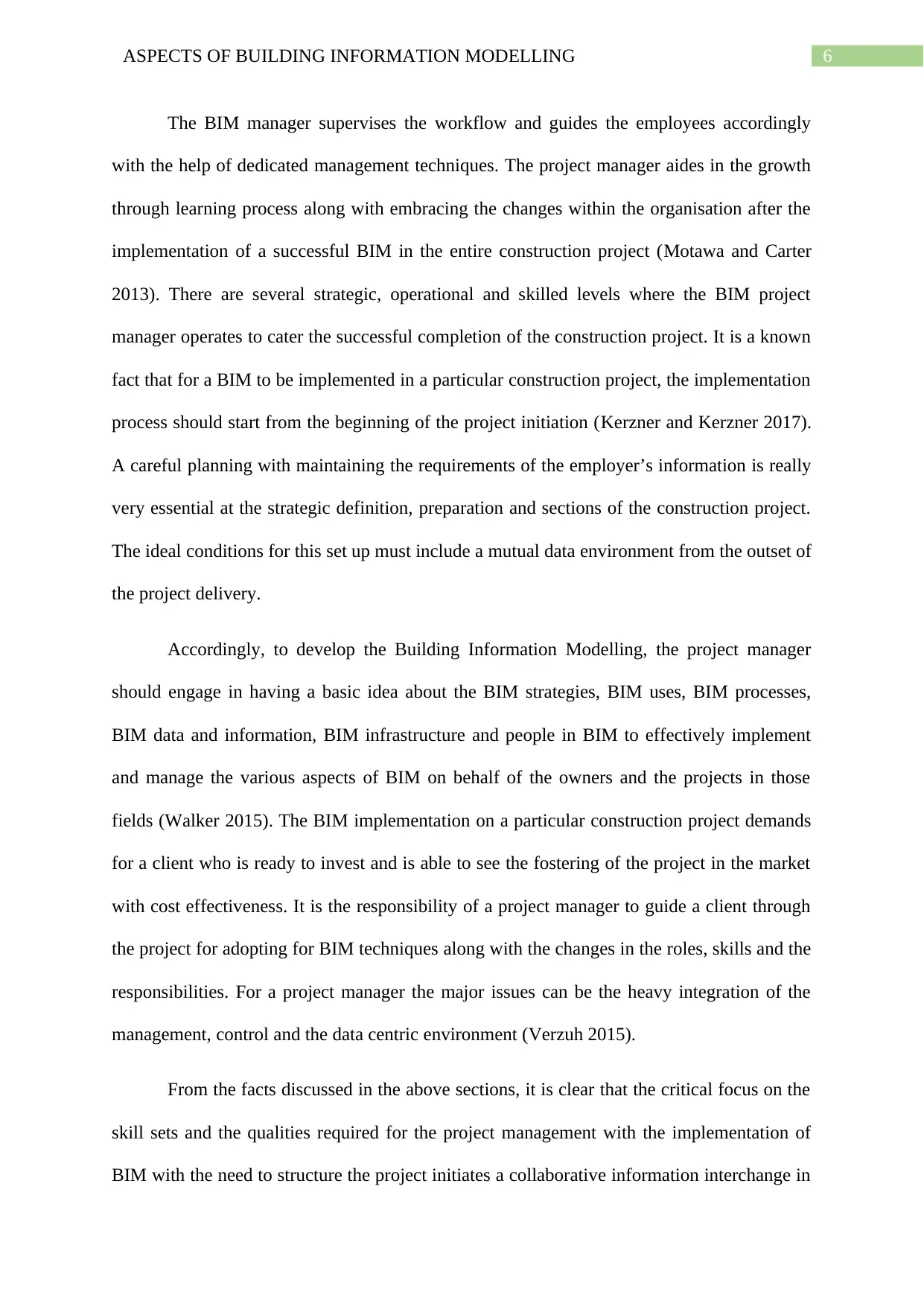
6ASPECTS OF BUILDING INFORMATION MODELLING
The BIM manager supervises the workflow and guides the employees accordingly
with the help of dedicated management techniques. The project manager aides in the growth
through learning process along with embracing the changes within the organisation after the
implementation of a successful BIM in the entire construction project (Motawa and Carter
2013). There are several strategic, operational and skilled levels where the BIM project
manager operates to cater the successful completion of the construction project. It is a known
fact that for a BIM to be implemented in a particular construction project, the implementation
process should start from the beginning of the project initiation (Kerzner and Kerzner 2017).
A careful planning with maintaining the requirements of the employer’s information is really
very essential at the strategic definition, preparation and sections of the construction project.
The ideal conditions for this set up must include a mutual data environment from the outset of
the project delivery.
Accordingly, to develop the Building Information Modelling, the project manager
should engage in having a basic idea about the BIM strategies, BIM uses, BIM processes,
BIM data and information, BIM infrastructure and people in BIM to effectively implement
and manage the various aspects of BIM on behalf of the owners and the projects in those
fields (Walker 2015). The BIM implementation on a particular construction project demands
for a client who is ready to invest and is able to see the fostering of the project in the market
with cost effectiveness. It is the responsibility of a project manager to guide a client through
the project for adopting for BIM techniques along with the changes in the roles, skills and the
responsibilities. For a project manager the major issues can be the heavy integration of the
management, control and the data centric environment (Verzuh 2015).
From the facts discussed in the above sections, it is clear that the critical focus on the
skill sets and the qualities required for the project management with the implementation of
BIM with the need to structure the project initiates a collaborative information interchange in
The BIM manager supervises the workflow and guides the employees accordingly
with the help of dedicated management techniques. The project manager aides in the growth
through learning process along with embracing the changes within the organisation after the
implementation of a successful BIM in the entire construction project (Motawa and Carter
2013). There are several strategic, operational and skilled levels where the BIM project
manager operates to cater the successful completion of the construction project. It is a known
fact that for a BIM to be implemented in a particular construction project, the implementation
process should start from the beginning of the project initiation (Kerzner and Kerzner 2017).
A careful planning with maintaining the requirements of the employer’s information is really
very essential at the strategic definition, preparation and sections of the construction project.
The ideal conditions for this set up must include a mutual data environment from the outset of
the project delivery.
Accordingly, to develop the Building Information Modelling, the project manager
should engage in having a basic idea about the BIM strategies, BIM uses, BIM processes,
BIM data and information, BIM infrastructure and people in BIM to effectively implement
and manage the various aspects of BIM on behalf of the owners and the projects in those
fields (Walker 2015). The BIM implementation on a particular construction project demands
for a client who is ready to invest and is able to see the fostering of the project in the market
with cost effectiveness. It is the responsibility of a project manager to guide a client through
the project for adopting for BIM techniques along with the changes in the roles, skills and the
responsibilities. For a project manager the major issues can be the heavy integration of the
management, control and the data centric environment (Verzuh 2015).
From the facts discussed in the above sections, it is clear that the critical focus on the
skill sets and the qualities required for the project management with the implementation of
BIM with the need to structure the project initiates a collaborative information interchange in
Paraphrase This Document
Need a fresh take? Get an instant paraphrase of this document with our AI Paraphraser
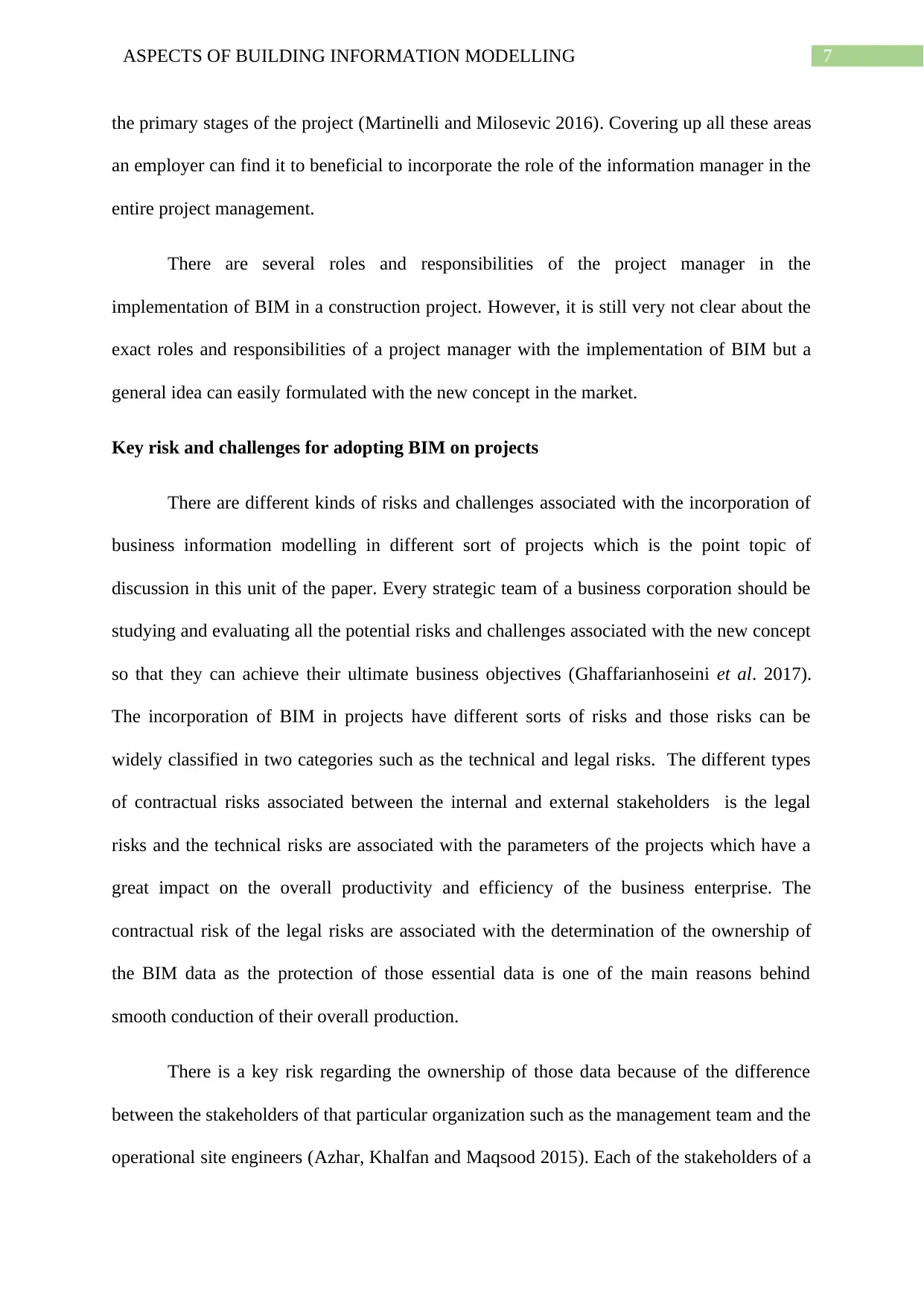
7ASPECTS OF BUILDING INFORMATION MODELLING
the primary stages of the project (Martinelli and Milosevic 2016). Covering up all these areas
an employer can find it to beneficial to incorporate the role of the information manager in the
entire project management.
There are several roles and responsibilities of the project manager in the
implementation of BIM in a construction project. However, it is still very not clear about the
exact roles and responsibilities of a project manager with the implementation of BIM but a
general idea can easily formulated with the new concept in the market.
Key risk and challenges for adopting BIM on projects
There are different kinds of risks and challenges associated with the incorporation of
business information modelling in different sort of projects which is the point topic of
discussion in this unit of the paper. Every strategic team of a business corporation should be
studying and evaluating all the potential risks and challenges associated with the new concept
so that they can achieve their ultimate business objectives (Ghaffarianhoseini et al. 2017).
The incorporation of BIM in projects have different sorts of risks and those risks can be
widely classified in two categories such as the technical and legal risks. The different types
of contractual risks associated between the internal and external stakeholders is the legal
risks and the technical risks are associated with the parameters of the projects which have a
great impact on the overall productivity and efficiency of the business enterprise. The
contractual risk of the legal risks are associated with the determination of the ownership of
the BIM data as the protection of those essential data is one of the main reasons behind
smooth conduction of their overall production.
There is a key risk regarding the ownership of those data because of the difference
between the stakeholders of that particular organization such as the management team and the
operational site engineers (Azhar, Khalfan and Maqsood 2015). Each of the stakeholders of a
the primary stages of the project (Martinelli and Milosevic 2016). Covering up all these areas
an employer can find it to beneficial to incorporate the role of the information manager in the
entire project management.
There are several roles and responsibilities of the project manager in the
implementation of BIM in a construction project. However, it is still very not clear about the
exact roles and responsibilities of a project manager with the implementation of BIM but a
general idea can easily formulated with the new concept in the market.
Key risk and challenges for adopting BIM on projects
There are different kinds of risks and challenges associated with the incorporation of
business information modelling in different sort of projects which is the point topic of
discussion in this unit of the paper. Every strategic team of a business corporation should be
studying and evaluating all the potential risks and challenges associated with the new concept
so that they can achieve their ultimate business objectives (Ghaffarianhoseini et al. 2017).
The incorporation of BIM in projects have different sorts of risks and those risks can be
widely classified in two categories such as the technical and legal risks. The different types
of contractual risks associated between the internal and external stakeholders is the legal
risks and the technical risks are associated with the parameters of the projects which have a
great impact on the overall productivity and efficiency of the business enterprise. The
contractual risk of the legal risks are associated with the determination of the ownership of
the BIM data as the protection of those essential data is one of the main reasons behind
smooth conduction of their overall production.
There is a key risk regarding the ownership of those data because of the difference
between the stakeholders of that particular organization such as the management team and the
operational site engineers (Azhar, Khalfan and Maqsood 2015). Each of the stakeholders of a
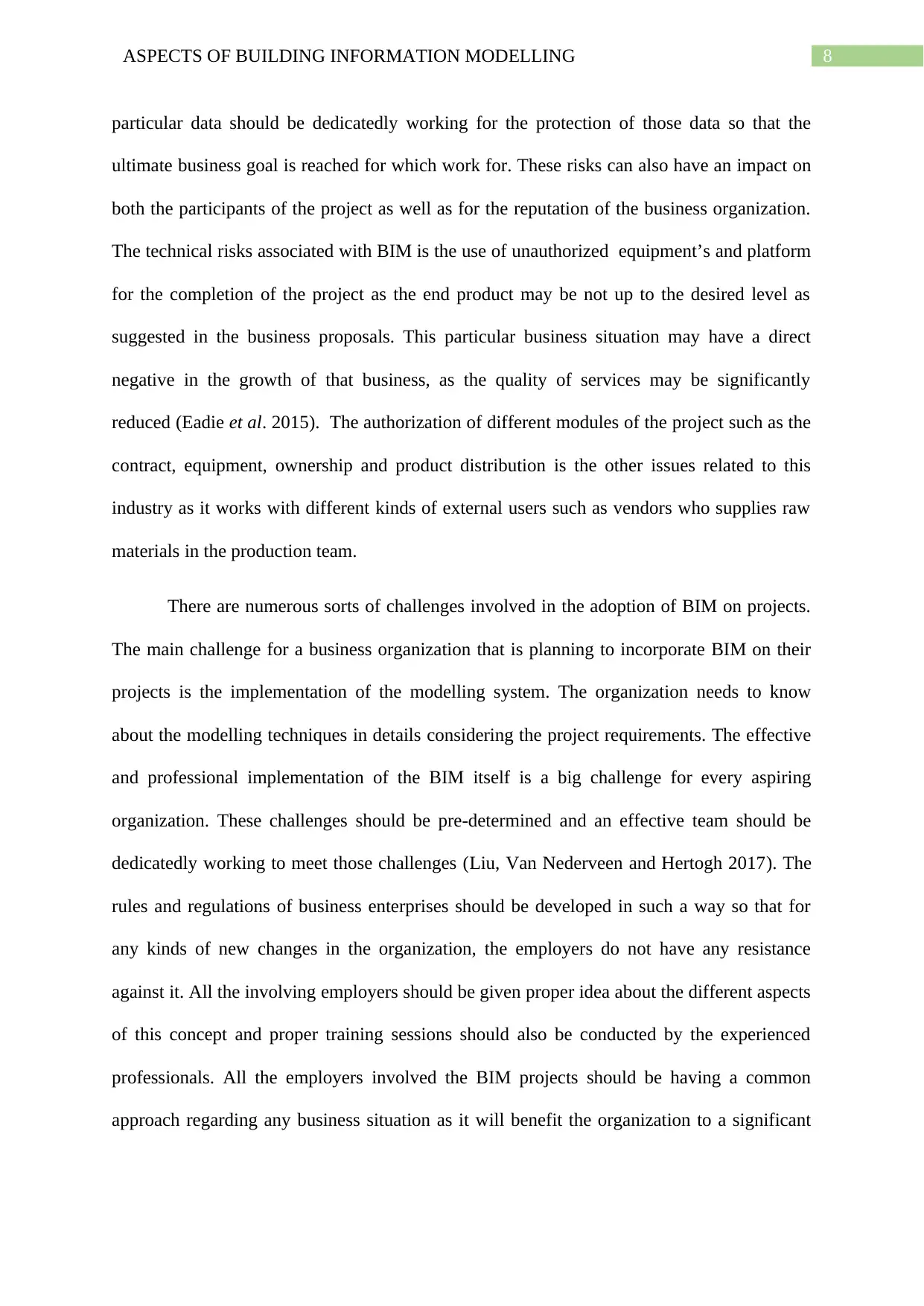
8ASPECTS OF BUILDING INFORMATION MODELLING
particular data should be dedicatedly working for the protection of those data so that the
ultimate business goal is reached for which work for. These risks can also have an impact on
both the participants of the project as well as for the reputation of the business organization.
The technical risks associated with BIM is the use of unauthorized equipment’s and platform
for the completion of the project as the end product may be not up to the desired level as
suggested in the business proposals. This particular business situation may have a direct
negative in the growth of that business, as the quality of services may be significantly
reduced (Eadie et al. 2015). The authorization of different modules of the project such as the
contract, equipment, ownership and product distribution is the other issues related to this
industry as it works with different kinds of external users such as vendors who supplies raw
materials in the production team.
There are numerous sorts of challenges involved in the adoption of BIM on projects.
The main challenge for a business organization that is planning to incorporate BIM on their
projects is the implementation of the modelling system. The organization needs to know
about the modelling techniques in details considering the project requirements. The effective
and professional implementation of the BIM itself is a big challenge for every aspiring
organization. These challenges should be pre-determined and an effective team should be
dedicatedly working to meet those challenges (Liu, Van Nederveen and Hertogh 2017). The
rules and regulations of business enterprises should be developed in such a way so that for
any kinds of new changes in the organization, the employers do not have any resistance
against it. All the involving employers should be given proper idea about the different aspects
of this concept and proper training sessions should also be conducted by the experienced
professionals. All the employers involved the BIM projects should be having a common
approach regarding any business situation as it will benefit the organization to a significant
particular data should be dedicatedly working for the protection of those data so that the
ultimate business goal is reached for which work for. These risks can also have an impact on
both the participants of the project as well as for the reputation of the business organization.
The technical risks associated with BIM is the use of unauthorized equipment’s and platform
for the completion of the project as the end product may be not up to the desired level as
suggested in the business proposals. This particular business situation may have a direct
negative in the growth of that business, as the quality of services may be significantly
reduced (Eadie et al. 2015). The authorization of different modules of the project such as the
contract, equipment, ownership and product distribution is the other issues related to this
industry as it works with different kinds of external users such as vendors who supplies raw
materials in the production team.
There are numerous sorts of challenges involved in the adoption of BIM on projects.
The main challenge for a business organization that is planning to incorporate BIM on their
projects is the implementation of the modelling system. The organization needs to know
about the modelling techniques in details considering the project requirements. The effective
and professional implementation of the BIM itself is a big challenge for every aspiring
organization. These challenges should be pre-determined and an effective team should be
dedicatedly working to meet those challenges (Liu, Van Nederveen and Hertogh 2017). The
rules and regulations of business enterprises should be developed in such a way so that for
any kinds of new changes in the organization, the employers do not have any resistance
against it. All the involving employers should be given proper idea about the different aspects
of this concept and proper training sessions should also be conducted by the experienced
professionals. All the employers involved the BIM projects should be having a common
approach regarding any business situation as it will benefit the organization to a significant
⊘ This is a preview!⊘
Do you want full access?
Subscribe today to unlock all pages.

Trusted by 1+ million students worldwide
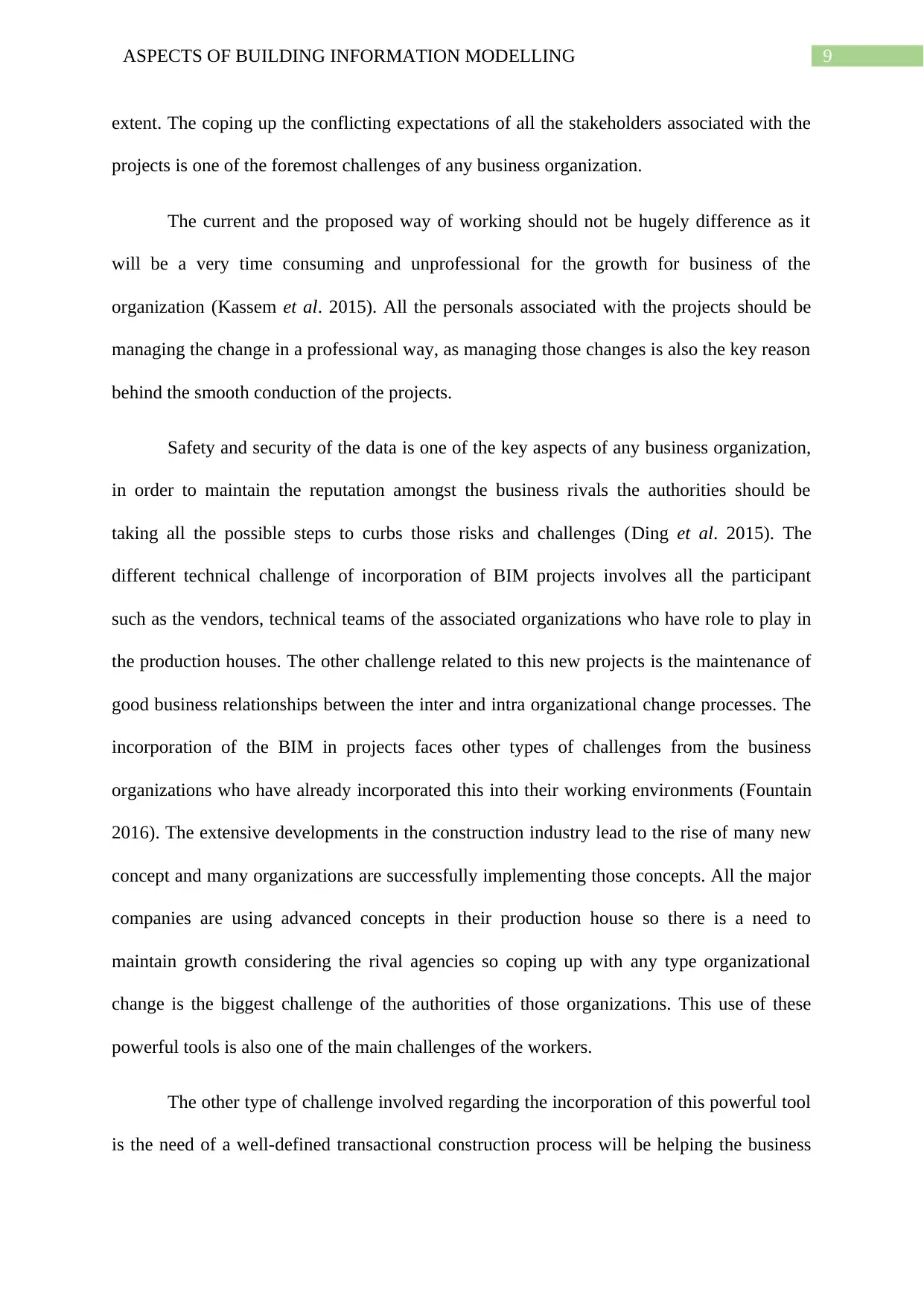
9ASPECTS OF BUILDING INFORMATION MODELLING
extent. The coping up the conflicting expectations of all the stakeholders associated with the
projects is one of the foremost challenges of any business organization.
The current and the proposed way of working should not be hugely difference as it
will be a very time consuming and unprofessional for the growth for business of the
organization (Kassem et al. 2015). All the personals associated with the projects should be
managing the change in a professional way, as managing those changes is also the key reason
behind the smooth conduction of the projects.
Safety and security of the data is one of the key aspects of any business organization,
in order to maintain the reputation amongst the business rivals the authorities should be
taking all the possible steps to curbs those risks and challenges (Ding et al. 2015). The
different technical challenge of incorporation of BIM projects involves all the participant
such as the vendors, technical teams of the associated organizations who have role to play in
the production houses. The other challenge related to this new projects is the maintenance of
good business relationships between the inter and intra organizational change processes. The
incorporation of the BIM in projects faces other types of challenges from the business
organizations who have already incorporated this into their working environments (Fountain
2016). The extensive developments in the construction industry lead to the rise of many new
concept and many organizations are successfully implementing those concepts. All the major
companies are using advanced concepts in their production house so there is a need to
maintain growth considering the rival agencies so coping up with any type organizational
change is the biggest challenge of the authorities of those organizations. This use of these
powerful tools is also one of the main challenges of the workers.
The other type of challenge involved regarding the incorporation of this powerful tool
is the need of a well-defined transactional construction process will be helping the business
extent. The coping up the conflicting expectations of all the stakeholders associated with the
projects is one of the foremost challenges of any business organization.
The current and the proposed way of working should not be hugely difference as it
will be a very time consuming and unprofessional for the growth for business of the
organization (Kassem et al. 2015). All the personals associated with the projects should be
managing the change in a professional way, as managing those changes is also the key reason
behind the smooth conduction of the projects.
Safety and security of the data is one of the key aspects of any business organization,
in order to maintain the reputation amongst the business rivals the authorities should be
taking all the possible steps to curbs those risks and challenges (Ding et al. 2015). The
different technical challenge of incorporation of BIM projects involves all the participant
such as the vendors, technical teams of the associated organizations who have role to play in
the production houses. The other challenge related to this new projects is the maintenance of
good business relationships between the inter and intra organizational change processes. The
incorporation of the BIM in projects faces other types of challenges from the business
organizations who have already incorporated this into their working environments (Fountain
2016). The extensive developments in the construction industry lead to the rise of many new
concept and many organizations are successfully implementing those concepts. All the major
companies are using advanced concepts in their production house so there is a need to
maintain growth considering the rival agencies so coping up with any type organizational
change is the biggest challenge of the authorities of those organizations. This use of these
powerful tools is also one of the main challenges of the workers.
The other type of challenge involved regarding the incorporation of this powerful tool
is the need of a well-defined transactional construction process will be helping the business
Paraphrase This Document
Need a fresh take? Get an instant paraphrase of this document with our AI Paraphraser
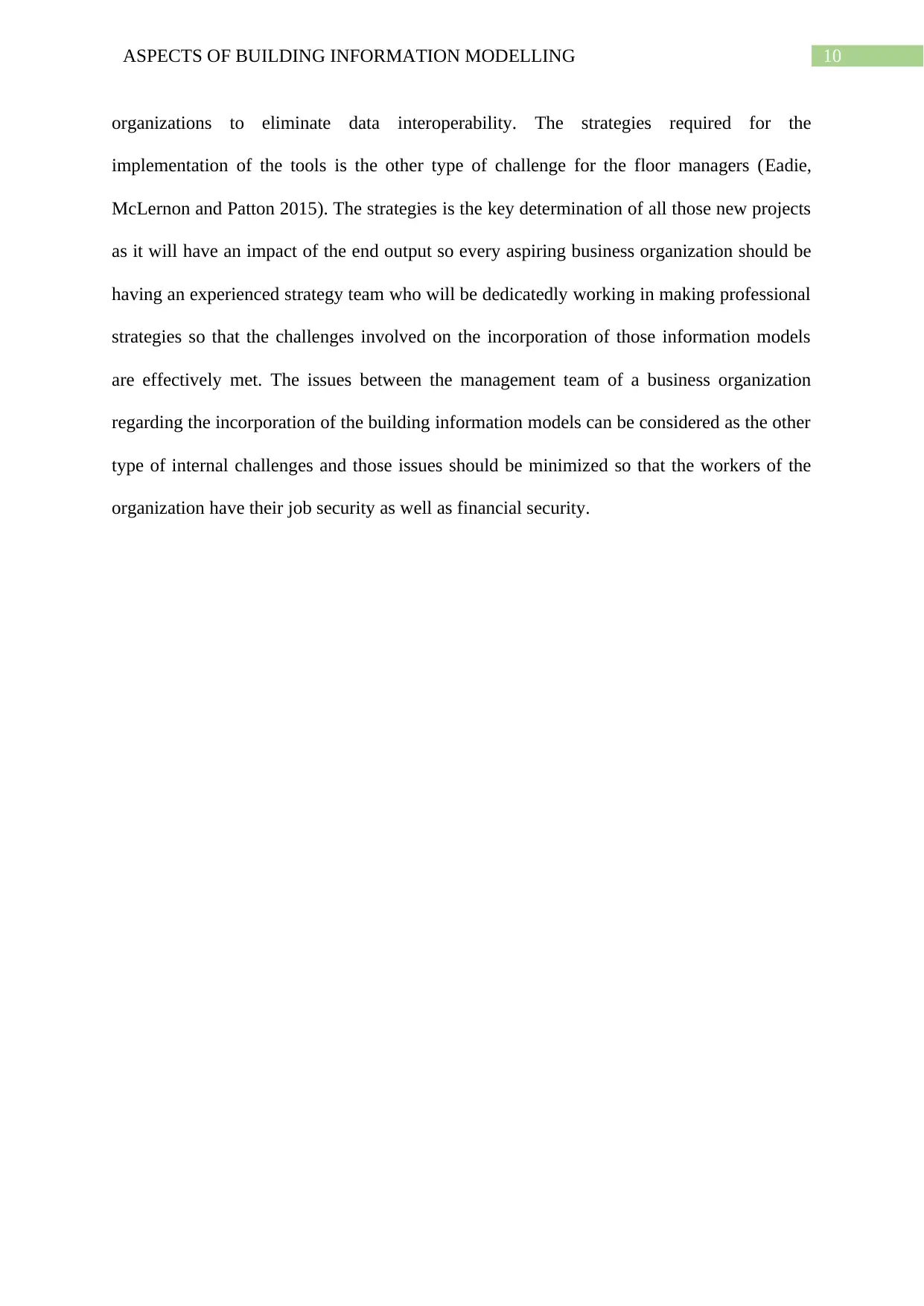
10ASPECTS OF BUILDING INFORMATION MODELLING
organizations to eliminate data interoperability. The strategies required for the
implementation of the tools is the other type of challenge for the floor managers (Eadie,
McLernon and Patton 2015). The strategies is the key determination of all those new projects
as it will have an impact of the end output so every aspiring business organization should be
having an experienced strategy team who will be dedicatedly working in making professional
strategies so that the challenges involved on the incorporation of those information models
are effectively met. The issues between the management team of a business organization
regarding the incorporation of the building information models can be considered as the other
type of internal challenges and those issues should be minimized so that the workers of the
organization have their job security as well as financial security.
organizations to eliminate data interoperability. The strategies required for the
implementation of the tools is the other type of challenge for the floor managers (Eadie,
McLernon and Patton 2015). The strategies is the key determination of all those new projects
as it will have an impact of the end output so every aspiring business organization should be
having an experienced strategy team who will be dedicatedly working in making professional
strategies so that the challenges involved on the incorporation of those information models
are effectively met. The issues between the management team of a business organization
regarding the incorporation of the building information models can be considered as the other
type of internal challenges and those issues should be minimized so that the workers of the
organization have their job security as well as financial security.
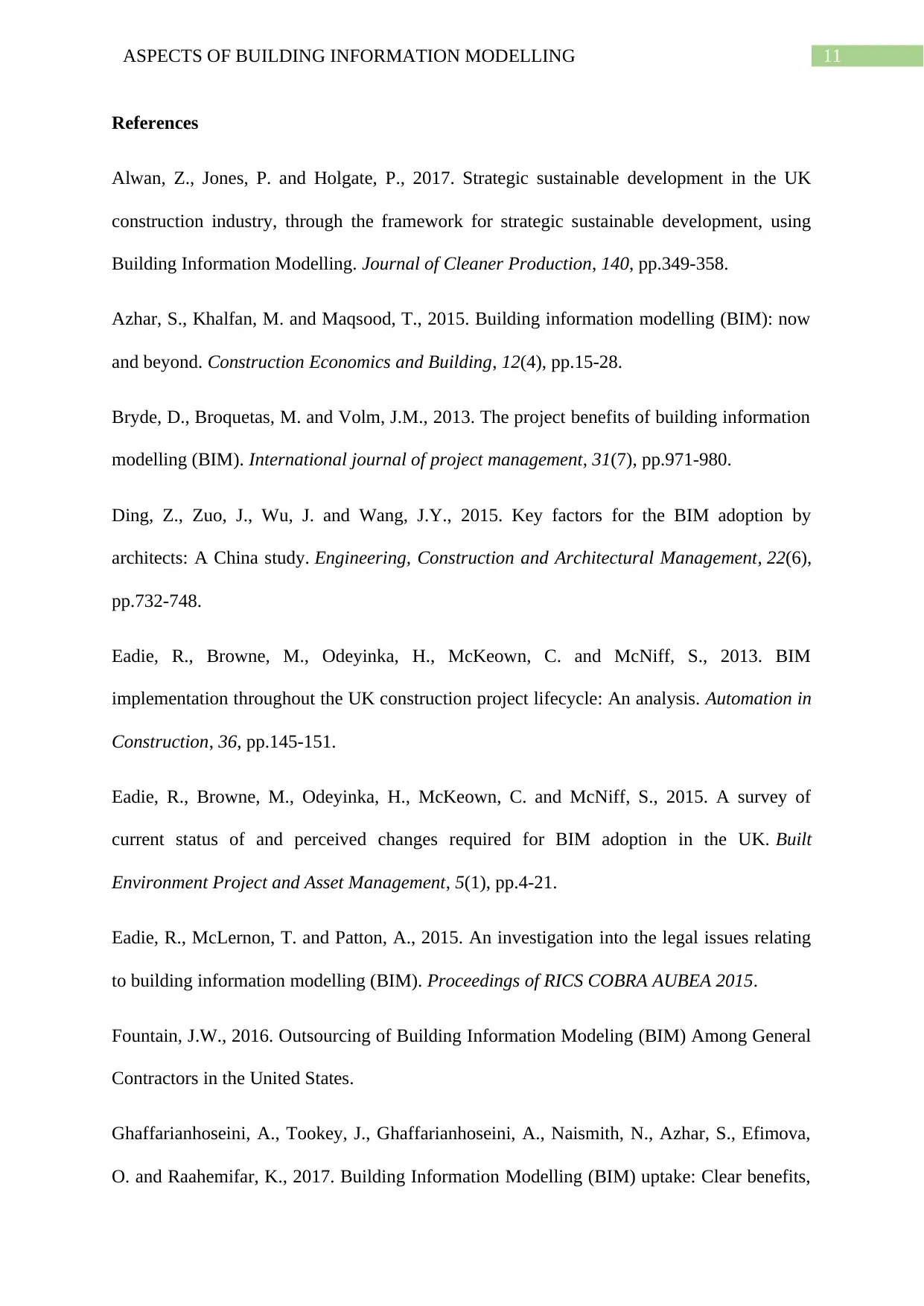
11ASPECTS OF BUILDING INFORMATION MODELLING
References
Alwan, Z., Jones, P. and Holgate, P., 2017. Strategic sustainable development in the UK
construction industry, through the framework for strategic sustainable development, using
Building Information Modelling. Journal of Cleaner Production, 140, pp.349-358.
Azhar, S., Khalfan, M. and Maqsood, T., 2015. Building information modelling (BIM): now
and beyond. Construction Economics and Building, 12(4), pp.15-28.
Bryde, D., Broquetas, M. and Volm, J.M., 2013. The project benefits of building information
modelling (BIM). International journal of project management, 31(7), pp.971-980.
Ding, Z., Zuo, J., Wu, J. and Wang, J.Y., 2015. Key factors for the BIM adoption by
architects: A China study. Engineering, Construction and Architectural Management, 22(6),
pp.732-748.
Eadie, R., Browne, M., Odeyinka, H., McKeown, C. and McNiff, S., 2013. BIM
implementation throughout the UK construction project lifecycle: An analysis. Automation in
Construction, 36, pp.145-151.
Eadie, R., Browne, M., Odeyinka, H., McKeown, C. and McNiff, S., 2015. A survey of
current status of and perceived changes required for BIM adoption in the UK. Built
Environment Project and Asset Management, 5(1), pp.4-21.
Eadie, R., McLernon, T. and Patton, A., 2015. An investigation into the legal issues relating
to building information modelling (BIM). Proceedings of RICS COBRA AUBEA 2015.
Fountain, J.W., 2016. Outsourcing of Building Information Modeling (BIM) Among General
Contractors in the United States.
Ghaffarianhoseini, A., Tookey, J., Ghaffarianhoseini, A., Naismith, N., Azhar, S., Efimova,
O. and Raahemifar, K., 2017. Building Information Modelling (BIM) uptake: Clear benefits,
References
Alwan, Z., Jones, P. and Holgate, P., 2017. Strategic sustainable development in the UK
construction industry, through the framework for strategic sustainable development, using
Building Information Modelling. Journal of Cleaner Production, 140, pp.349-358.
Azhar, S., Khalfan, M. and Maqsood, T., 2015. Building information modelling (BIM): now
and beyond. Construction Economics and Building, 12(4), pp.15-28.
Bryde, D., Broquetas, M. and Volm, J.M., 2013. The project benefits of building information
modelling (BIM). International journal of project management, 31(7), pp.971-980.
Ding, Z., Zuo, J., Wu, J. and Wang, J.Y., 2015. Key factors for the BIM adoption by
architects: A China study. Engineering, Construction and Architectural Management, 22(6),
pp.732-748.
Eadie, R., Browne, M., Odeyinka, H., McKeown, C. and McNiff, S., 2013. BIM
implementation throughout the UK construction project lifecycle: An analysis. Automation in
Construction, 36, pp.145-151.
Eadie, R., Browne, M., Odeyinka, H., McKeown, C. and McNiff, S., 2015. A survey of
current status of and perceived changes required for BIM adoption in the UK. Built
Environment Project and Asset Management, 5(1), pp.4-21.
Eadie, R., McLernon, T. and Patton, A., 2015. An investigation into the legal issues relating
to building information modelling (BIM). Proceedings of RICS COBRA AUBEA 2015.
Fountain, J.W., 2016. Outsourcing of Building Information Modeling (BIM) Among General
Contractors in the United States.
Ghaffarianhoseini, A., Tookey, J., Ghaffarianhoseini, A., Naismith, N., Azhar, S., Efimova,
O. and Raahemifar, K., 2017. Building Information Modelling (BIM) uptake: Clear benefits,
⊘ This is a preview!⊘
Do you want full access?
Subscribe today to unlock all pages.

Trusted by 1+ million students worldwide
1 out of 14
Related Documents
Your All-in-One AI-Powered Toolkit for Academic Success.
+13062052269
info@desklib.com
Available 24*7 on WhatsApp / Email
![[object Object]](/_next/static/media/star-bottom.7253800d.svg)
Unlock your academic potential
Copyright © 2020–2025 A2Z Services. All Rights Reserved. Developed and managed by ZUCOL.





